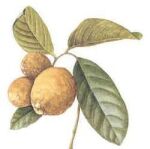| Common Name: |
Chaulmoogra |
| Botanical Name: |
Hydnocarpus kurzii syn. Taraktogenos kurzii |
| Genus: |
Hydnocarpus |
| Family: |
Flacourtiaceae |
| Native Location: |
SE Asia |
| Cultivation: |
Rich, moist, well-drained soil in moderate humidity. |
| Propagation: |
By seed sown when ripe at 18-21°C (64-70°F); by grafting in late spring or early summer. |
| Harvest: |
Seeds are separated from berries when ripe and used whole for decoctions, powdered for pills and pastes, or crushed for oil. Oil is given as an emulsion or by injection. |
| Height: |
20-30m (70-100ft) |
| Width: |
15m (50ft) |
| Hardiness: |
Min. 12-14°C (54-57°F) |
| Parts Used: |
Seeds (da feng zi), oil |
| Properties: |
An acrid, sedative herb, with an unpleasant smell, that lowers fever and expels intestinal worms. It is a potent antibiotic and alterative. In excess, it is a cardiovascular depressant. |
| Medicinal Uses: |
Internally for leprosy, scabies, eczema, psoriasis, scrofula, ringworm, and intestinal worms. May cause vomiting, dizziness, and breathing difficulties. Externally as a dressing for skin diseases and anal fissure, usually in the form of an ointment, 10 percent oil to 90 percent soft paraffin; also combined with walnut oil and pork lard for ringworm; with calomel and sesame oil for leprosy; or with sulphur and camphor for scabies. For use by qualified practioners only. |
| Bibliography: |
Encylopedia of Herbs by Deni Brown Copyright ©: 1995, 2001 Dorling Kindersley Limited pg 238
|

